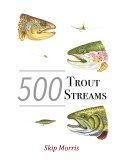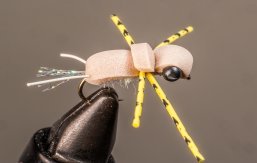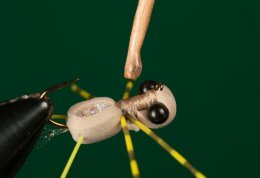Wet Fly Hackles Tying Steps
(Wet Fly Hackles, Part 2)
In this article, Wet Fly Hackles Tying Steps, Skip explains how to tie wet fly hackles, demonstrating standard, half-stripped, and reverse-wound methods.
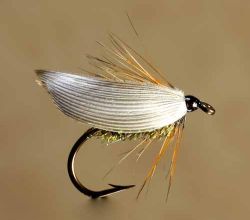 A classic wet fly, the Leadwing Coachman
A classic wet fly, the Leadwing Coachman
tied by Skip Morris
Here are three good methods for creating a wet-fly hackle collar, and though each method has its drawbacks, each also offers specific advantages.
Wet Fly Hackles Tying Steps:
The Standard Approach
The standard approach of wrapping the hackle forward, then binding its tip, is the easiest. And it's probably just fine from the trout's perspective.
Here are the standard wet fly hackles tying steps:
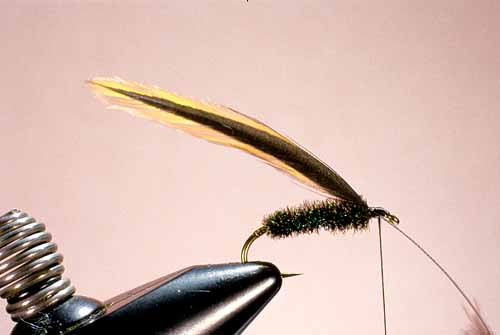 Step 1
Step 1
1. When the body and tag and tail of the fly are completed (if there is a tag and tail), bind a hackle by the stripped base of its stem at the front of the body.
The hackle should slant back, over the body. Trim off the butt of the hackle.
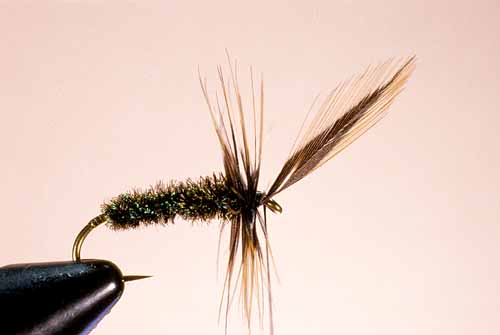 Step 2
Step 2
2. Advance the thread to just behind the hook's eye. Wind the hackle forward in three or four close turns, secure the tip of the hackle under a few tight
thread-turns, trim the hackle's tip closely.
Now is the usual time to bind on the wings, but as an alternate approach you could also have bound them
on before adding the hackle collar.
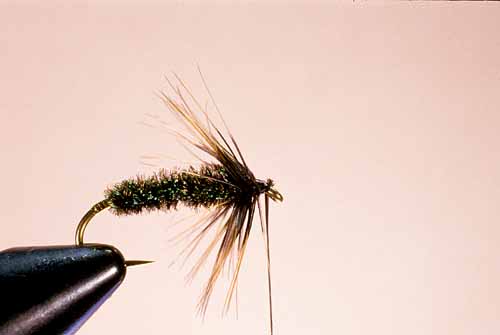 Step 3
Step 3
3. If you want the fibers to sweep back (which most tiers do) just pinch them down hard. This is a hackle collar that was pinched down in
this fashion.
Wet Fly Hackles Tying Steps:
The Half-Stripped Hackle Method
The half-stripped hackle offers a very sparse collar—just right for persnickety trout and a dead-drift or barely manipulated fly. And only one simple step is added to the standard approach.
Here's the half-stripped hackle method for tying wet fly hackles:
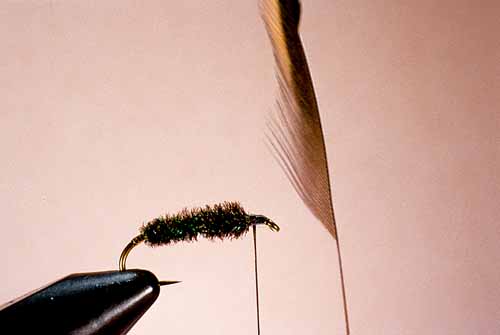 Step 1
Step 1
1. Winding a half-stripped hackle makes it easy to create a sparse hackle collar that is more realistic than a bushy collar and more likely to
convince finicky trout.
Begin by stripping the fibers from the base of the hackle.
You want to strip the correct side of the hackle
completely—the correct side is the one that, after the hackle is bound by its stem at the front of the body, allows you to wind the hackle forward with
the natural curve of the remaining fibers sweeping back, and with the striped side of the stem down against the hook.
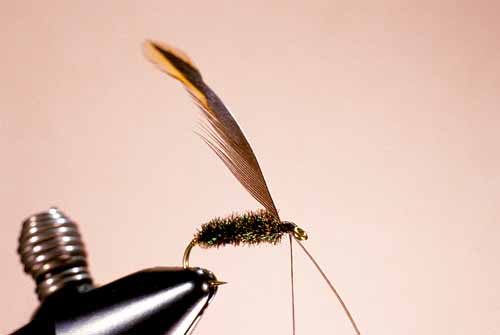 Step 2
Step 2
2. Bind the hackle by its stem at the front of the body, slanting back—the hackle should lie on its stripped side—and complete the process of
making a hackle collar just as described in the first two captions.
Three turns of hackle should do it.
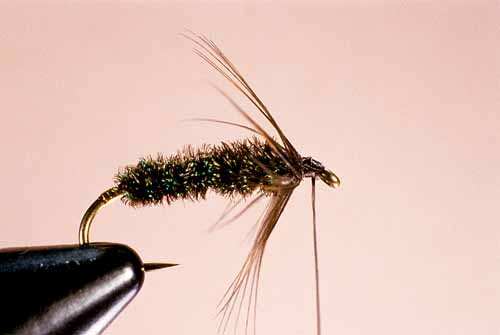 Step 3
Step 3
3. Here is the hackle collar made from the half-stripped hackle after it has been pinched down to set the fibers back.
Compare the results in this photograph with the results of the standard approach in photograph number three(step 3 in the standard approach) and you'll see that the half-stripped
hackle collar is considerably thinner than the full-hackle collar.
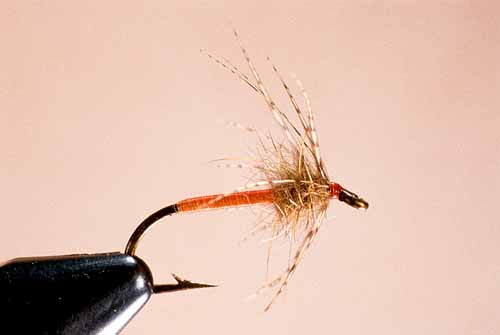 Step 4
Step 4
4. I like the half-stripped hackle best with "soft-hackle" flies, fly patterns of a specific styling that includes no tail or wings and a very
soft hackle collar of partridge flank, hen-saddle, or the like.
Here is the Partridge and Orange soft-hackle fly with a half-stripped partridge hackle.
Wet Fly Hackles Tying Steps:
The Reverse-Wound Method
The reverse-wound hackle isn't much more difficult to make than the standard, just a couple of quick extra steps. The big advantages to this method are:
- the stem of the hackle is reinforced by turns of thread, and consequently made tougher, and
- the fibers slant naturally back, and can be slanted further with a couple of quick pinches.
And, here's the last technique...the reverse-wound method of tying wet fly hackles:
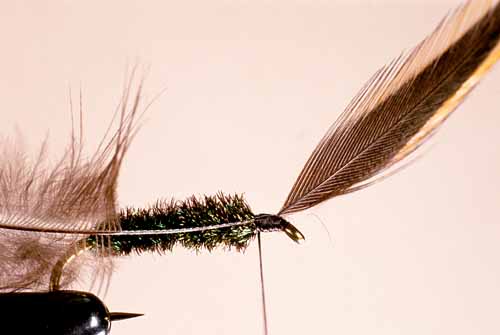 Step 1
Step 1
1. To make the reverse-wound wet-fly hackle, bind the hackle by its stripped stem up just behind the hook's eye—not at the front of the body as usual.
The hackle should project forward off the eye, not back over the body as in the previous two methods.
Wind the thread back to the front of the body.
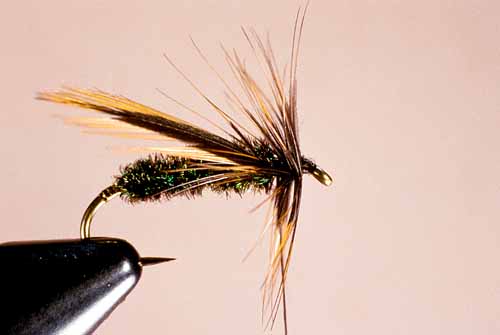 Step 2
Step 2
2. Trim off the stem. Wind the hackle back to the front of the body in close turns. Wind a turn or two of thread over the tip of the hackle.
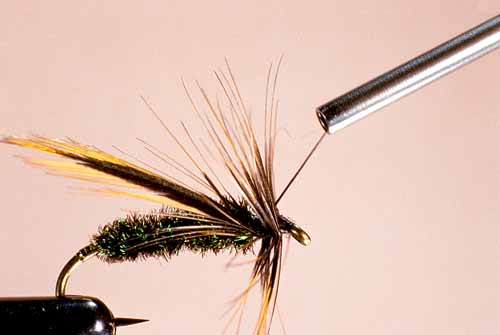 Step 3
Step 3
3. Continue winding the thread, but now spiral it forward, right through the hackle
to the eye.
Now the stem of the hackle is crossed a few times by tight turns of thread—this really reinforces the hackle and makes it durable.
To complete the hackle, find its tip and trim it out, then pinch back the fibers.
Reverse-wound hackle completed.
In Wet Fly Hackles, Part 1, Skip talks about the debate over the materials
best used for hackles on wet flies.
Click here to hear Skip's interviews on popular podcasts...
*Announcements*
Skip has an essay in Big Sky Journal's annual Fly Fishing issue, called "Montana Hoppers: the Princess and the Brute" released February 1, 2023. Skip rewrote it a bit; I painted and illustrated it here, on our website. Here's the link on our web page to check it out:
Click here to read Skip's essay Montana Hoppers: The Princess and the Brute...
Skip's latest books:
Top 12 Dry Flies for Trout Streams: How, When, and Where to Fish Them, is now available on Amazon as an ebook...check it out! Click on the links below to go to the information page on Top 12 Dry Flies (the link to Amazon is at the bottom of the page...)
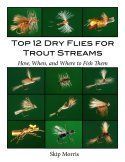 Top 12 Dry Flies for Trout Streams: How, When, and Where to Fish Them
Top 12 Dry Flies for Trout Streams: How, When, and Where to Fish Them
Click here to get more information about
Top 12 Dry Flies for Trout Streams: How, When, and Where to Fish Them (the link to Amazon is at the bottom of the page)...
Top 12 Dry Flies for Trout Streams: How, When, and Where to Fish Them (the link to Amazon is at the bottom of the page)...
Top 12 Nymphs for Trout Streams: How, When, and Where to Fish Them, 2nd Edition, originally published as an e-book only, is now available on Amazon as a paperback...check it out! Click on the links below to go to the information page on Top 12 Nymphs (the link to Amazon is at the bottom of the page...)
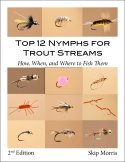 Top 12 Nymphs for Trout Streams: How, When, and Where to Fish Them (2nd Edition)
Top 12 Nymphs for Trout Streams: How, When, and Where to Fish Them (2nd Edition)
Click here to get more information about
Top 12 Nymphs for Trout Streams: How, When, and Where to Fish Them (2nd Edition). . .
Top 12 Nymphs for Trout Streams: How, When, and Where to Fish Them (2nd Edition). . .
Click here to get more information about Skip's e-book,
500 Trout Streams...
500 Trout Streams...
Skip's latest paperback book:
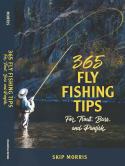 365 Fly Fishing Tips for Trout, Bass, and Panfish
365 Fly Fishing Tips for Trout, Bass, and Panfish
Click here to get more information about Skip's latest book,
365 Tips for Trout, Bass, and Panfish...
365 Tips for Trout, Bass, and Panfish...
Print Skip's chart for FREE:
Skip Morris's Trout-Fly Proportion Chart
Go to Skip Morris's Trout Fly Proportion Chart
Skip's Predator is available to buy...
Skip's ultra-popular Predator—a hit fly for bluegills and other panfishes and largemouth bass (also catches smallmouth bass and trout)—is being tied commercially by the Solitude Fly Company.
The Predator
CLICK HERE to learn more about or to purchase the Predator...
Learn to Tie Skip's Predator
Do you want to tie the Predator?
Tying the Predator
Skip shows you how to tie it on his YouTube Channel link, listed below:
CLICK HERE to see Skip's detailed video on how to tie the Predator...






